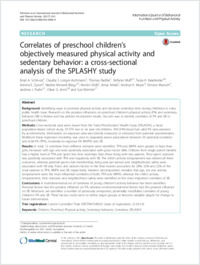Correlates of preschool children’s objectively measured physical activity and sedentary behavior: a cross-sectional analysis of the SPLASHY study
- Schmutz, Einat A. Universität Zürich
- Leeger-Aschmann, Claudia S. Universität Zürich
- Radtke, Thomas Universität Zürich
- Muff, Stefanie Universität Zürich
- Kakebeeke, Tanja H. Child Development Center, University Children’s Hospital Zürich
- Zysset, Annina E. Child Development Center, University Children’s Hospital Zürich
- Messerli-Bürgy, Nadine Universität Fribourg, Schweiz
- Stülb, Kerstin Universität Fribourg, Schweiz
- Arhab, Amar Centre Hospitalier Universitaire Vaudois (CHUV)
- Meyer, Andrea H. Universität Basel
- Munsch, Simone Universität Fribourg, Schweiz
- Puder, Jardena J. Centre Hospitalier Universitaire Vaudois (CHUV)
- Jenni, Oskar G. Child Development Center, University Children’s Hospital Zürich
- Kriemler, Susi Universität Zürich
-
05.01.2017
Published in:
- International Journal of Behavioral Nutrition and Physical Activity. - 2017, vol. 14, no. 1, p. 1-13
English
Background: Identifying ways to promote physical activity and decrease sedentary time during childhood is a key public health issue. Research on the putative influences on preschool children’s physical activity (PA) and sedentary behavior (SB) is limited and has yielded inconsistent results. Our aim was to identify correlates of PA and SB in preschool children. Methods: Cross-sectional data were drawn from the Swiss Preschoolers’ Health Study (SPLASHY), a Swiss population-based cohort study. Of 476 two to six year old children, 394 (54% boys) had valid PA data assessed by accelerometry. Information on exposure data was directly measured or extracted from parental questionnaires. Multilevel linear regression modeling was used to separately assess associations between 35 potential correlates and total PA (TPA), moderate-to-vigorous PA (MVPA) and SB. Results: In total, 12 correlates from different domains were identified. TPA and MVPA were greater in boys than girls, increased with age and were positively associated with gross motor skills. Children from single parent families had a higher level of TPA and spent less time sedentary than those living with two parents. Time spent outdoors was positively associated with TPA and negatively with SB. The child’s activity temperament was related all three outcomes, whereas parental sports club membership, living area per person and neighborhood safety were associated with SB only. Fixed and random factors in the final models accounted for 28%, 32% and 22% of the total variance in TPA, MVPA and SB, respectively. Variance decomposition revealed that age, sex and activity temperament were the most influential correlates of both, TPA and MVPA, whereas the child’s activity temperament, time outdoors and neighborhood safety were identified as the most important correlates of SB. Conclusions: A multidimensional set of correlates of young children’s activity behavior has been identified. Personal factors had the greatest influence on PA, whereas environmental-level factors had the greatest influence on SB. Moreover, we identified a number of previously unreported, potentially modifiable correlates of young children’s PA and SB. These factors could serve to define target groups or become valuable targets for change in future interventions.
- Faculty
- Faculté des lettres et des sciences humaines
- Department
- Département de Psychologie
- Language
-
- English
- Classification
- Medicine
- License
- License undefined
- Identifiers
-
- RERO DOC 323530
- DOI 10.1186/s12966-016-0456-9
- Persistent URL
- https://folia.unifr.ch/unifr/documents/307158
Statistics
Document views: 134
File downloads:
- int.journalofbehaviroalnutrition_correlatesofpreschoolchildrensobjectivelymeasuredphysicalactivityandsedentarybehavior-across-sectionalanalysisofthesplashystudy.pdf: 147
